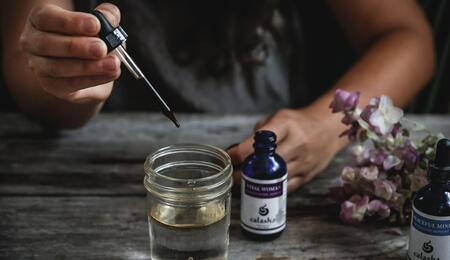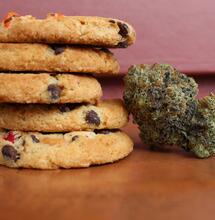Cannabis Tincture Renaissance: If You're Curious About Cannabis, Try Microdosing with Tincture

During the 19th-century, when Western medicine barely started discovering the analgesic qualities of cannabis, the plant was prescribed as a tincture. Allegedly, even Queen Victoria has been prescribed a remedy from her personal physician to treat period cramps in a tincture form. A century later, tinctures have made a grand come back on the cannabis stage.
Cannabis tinctures are one of the friendliest ways to use cannabis. Tinctures are an excellent choice for novice cannabis users, both those who want to try cannabis for medical purposes or use it recreationally. A tincture is basically an alcohol-based extract where cannabis plant material has been soaked into the alcohol to get the concoction. Below get all the answers you need to know on how to use cannabis tinctures, prepare one, store it, and dose it as per your needs.
What is a cannabis tincture?
Tinctures contain a high dose of alcohol, and they usually come in small glass bottles and have droppers with which users ingest the substance in the mouth cavity. As a method of consumption, cannabis tinctures allow for the most precise dosing to users. Similar to how cannabis oils are extracted, tinctures rely on a solvent to extract cannabinoids such as THC and CBD from the cannabis plant. That solvent for tinctures is alcohol, and basically, that’s the end product (solvents in cannabis oils are purged in further steps). Tinctures classify as cannabis edibles. To ensure that THC and other compounds found in cannabis are activated, the cannabis material used for tinctures needs to be decarboxylated, a process that optimizes the medicinal effects of the plant.
While tinctures are most often consumed sublingually (applied below the tongue and wait to swallow), they can also be taken orally (place in the mouth and directly swallow) or infused in foods just like cannabis oils. Consuming tinctures sublingually has the fastest effect, faster than your average space cookie, which may take up to an hour or two to work around your stomach. After the initial dose, users can quickly tell if they need an upgrade or wait for the next round of droplets. Tinctures, like other cannabis products, can be found and purchased in any medical cannabis dispensary. Alternatively, you can learn how to prepare cannabis tinctures yourself. It’s easy, and it’s rewarding.
How to make cannabis tincture at home?
Forget cooking butter and making a mess out of your kitchen as you try to bake cannabis-infused muffins or cakes. Tinctures are easier than that. Besides cannabis and high-quality edible alcohol, all you need is some basic kitchen items. Stick with food-grade alcohol that is safe for consumption and has sufficient alcohol content when you prepare cannabis tinctures. Cannabis resin will better dissolve in high alcohol content. You want to avoid isopropyl alcohol, which is not designed for consumption, therefore, it should never be used for preparing stuff like tinctures. Save isopropyl alcohols for disinfecting your doorknobs and frequently touched surfaces as you try to ward off viruses at home. Alternatively, you can opt for glycerin for preparing the tincture. Glycerine is naturally made from plants or sometimes animal fats and its syrupy odourless qualities can substitute alcohol. However, glycerine will not bind with cannabis compounds as efficiently as alcohol. As a result, cannabis tinctures based on glycerin are not as vigorous.
You can use both glycerine and alcohol to devise a more powerful cannabis tincture, that is if you truly want to test your chemistry skills. In which case, the first step would be to vaporize the alcohol from the tincture and the second to introduce glycerine in the concoction. But despite such a process would require advanced skills, it also requires extreme caution working to evaporate the alcohol, which is a flammable substance. So, it’s probably for the best that you stick with the safer procedures for preparing a tincture.
Ingredients and kitchen tools
Here’s a list of items that you may need for making your own cannabis tincture:
- Cannabis flowers (1 oz)
- Highly-potent, safe-to-consume alcohol like Everclear, vodka, or brandy (2 cups)
- Grinder
- Mason jar
- Cheesecloth
- Glass dropper bottles
- Glass measuring cup
- Oven-safe pan
- Aluminium foil
- Plastic gloves
Depending on how strong you like your tincture and how many ounces of cannabis you set aside for it, duplicate the alcohol dose accordingly (e.g., 2 ounces, 4 cups). For a more potent tincture, decrease the alcohol ratio by a third.
Decarboxylate your cannabis
Before you start preparing your tincture, you want to decarboxylate the cannabis material. Grind your flowers thoroughly and arrange them in the pan. Blanket the pan with aluminium foil as this will help preserve the weed from turning into char. Why do you need to do this? THC is the byproduct of heating THCA (Tetrahydrocannabinolic acid). The THC precursor is non-intoxicating, and heat helps it convert into its 'intoxicating' variant. THCA begins to transform into THC or decarboxylate at roughly 220°F/105°C after around half an hour of exposure. For full decarboxylation, you may want to wait for up to two hours.
People have different approaches to decarboxylating. Some prefer to set lower temperatures for heating as this helps preserve terpenes, which are also important to extract beyond juicing the THC or CBD. Using lower temperatures extends the time for waiting, however. A tried decarboxylating approach is to preheat the oven to 230°F/110°C and expose the weed to heat for slightly less than two hours (105-110 minutes). Decarboxylating may be the most challenging step towards making your cannabis tincture, but past this point, the rest is easy.
The next steps
Step 1: Take a mason jar filled with high potent alcohol like Everclear, or Vodka or Brandy and add your decarboxylated cannabis. The plant material needs to be entirely immersed in the alcohol of your choice. Step 2: Seal the jar and let it stay like that for a couple of weeks. Shake the concoction once every day. Some sources also suggest placing the jar in the fridge as the cold helps facilitate a finer concoction, but that’s up to you to try. Step 3: When you’ve had enough of waiting, take a cheesecloth to squeeze the liquid out of the mason jar. Using a glass measuring cup might be handy. You also want to manually squeeze the plant material at the end so that you juice out more liquid from the mason jar. Use gloves to protect your hands while you do the squeezing.
Storage and dosing
If you are not to use the tincture immediately, keep it in a jar for a little longer. If not, transfer the tincture into glass dropper bottles, which are perfect for controlling the dosage. Whatever you do, remember that tincture remedies are best stored in cold and dark places. This way, they could last for years. On the other hand, heat, light and air exposure negatively affect tincture potency. Once you’ve purchased or made your own cannabis tincture, it’s easy to test with dosages. Start with a small dosage, like 1 mL on day 1, and gradually increase until you find the dose that satisfies you. Use the dropper to apply your preferred tincture dosage under your tongue and wait for up to two minutes before swallowing the ingestion. You should be able to feel the effects quickly, in between 10-30 minutes. Some people drop the tincture on the tongue and don’t wait two minutes to swallow. Others enrich their meals with tinctures, but in this case, the effect will be delayed as with some other cannabis edibles.
What does it mean if the tincture burns under the tongue?
Some cannabis tincture users report that they sometimes experience a burning sensation under the tongue after a few drops of tincture. Such a reaction can be expected, primarily because tinctures use high-grade alcohol for preparation. It’s usually nothing to worry about, however, if you would rather not want any itching in your mouth cavity, opt for the other two methods of ingesting the tincture, direct in the mouth and swallow or infuse it in your juice, soup or pudding. Alternatively, opt for tinctures where glycerine has been used as the solvent.
What are the benefits of using cannabis tinctures?
Cannabis tinctures are some of the oldest methods of preparing cannabis, especially in medical practice. For those who want to avoid smokable cannabis, this might be an ideal solution. Ingested sublingually or under the tongue, tinctures promise faster onset and effects that last longer, up to 4 hours. Unlike most other cannabis edibles, tinctures are calorie-free, although some medical users may benefit from infusing the tincture into snacks and meals and increasing their appetite. Tinctures are one of the most discrete methods for consuming cannabis, which depending on where you live and with who you live, might be hard-to-digest information among family and friends. One of the greatest benefits of using cannabis tinctures is that users have a firmer grasp of consumption dosage. By taking a few drops at a time, users can gradually increase until they feel comfortable and the coveted effects kick in the body.
What’s the difference between THC and CBD tinctures?
Cannabis merchandise includes both THC- and CBD-based cannabis tinctures, with some tinctures mixing both compounds in various ratios. While both THC and CBD dominant cannabis tinctures ought to bring the same medical effects, CBD will do so without causing any mind-altering effects. Also, as CBD and THC face different legal obstacles, this affects the availability of tinctures. Tinctures containing over 3% THC can only be legally purchased in states where cannabis is legalised. On the other hand, CBD-rich tinctures can be easier to come by. Learning how to prepare your own cannabis tincture is easy, and you can always secure a stash even when the kind of tincture you are looking for is not available in the dispensary near you.



